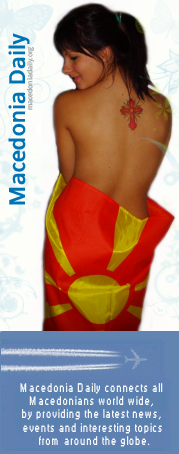UNEARTHING OF ANCIENT CITY OF KING FILIP II IN OHRID

Culture.
The department of prehistory of the Ohrid Museum institute have started with researching and unearthing at the archeological site above the Sv.Erazmo church at the northern entrance of the city of Ohrid, where, according to Pasko Kuzman, the ancient settlement of the Macedonian tribe, the Engelani, can be found.
It's about a very important site which for the first time has been researched by German archeologists in the year of 1931. It is assumed that the fortress on the site has been built by the powerfull Macedonian king, Filip II, the father of Alexander the Great, on his first visit to the Ohrid region (Lihnitida), when he expanded the Macedonian kingdom.
According to the researchers, the fortress has been build with huge megalithic stone bloks of about 2 meters long and 90 centimeters wide. Because of the use of these materials, the fortress has been called; "the Cyclop walls".
The project, which has been named; Engelana, will continue in three fases in the next five years. The first fase will costs about 60 million denars. The site is planned to be a big tourist destination when finished.
[Ohridnews]


























BALCAN CLOWNS THE CIRCUS IS BACK
STUPID FYROMIANS
Posted by Anonymous |
13:46
Anonymous |
13:46
The Pella curse tablet, a text written in a distinct Doric Greek idiom, found in 1986, dated to between mid to early 4th century BC, has been forwarded as an argument that the ancient Macedonian language was a dialect of North-Western Greek, part of the Doric dialects.[2] Before the discovery it was proposed that the Macedonian dialect was an early form of Greek, spoken alongside Doric proper at that time.[3]
Posted by Anonymous |
15:35
Anonymous |
15:35
The language of the ancient Macedonians. It was spoken in Macedon during the 1st millennium BC. Marginalized from the 5th century BC, it was gradually replaced by the Koine Greek dialect of the Hellenistic period.
The Pella curse tablet, a text written in a distinct Doric Greek idiom, found in 1986, dated to between mid to early 4th century BC, has been forwarded as an argument that the ancient Macedonian language was a dialect of North-Western Greek, part of the Doric dialects.[2] Before the discovery it was proposed that the Macedonian dialect was an early form of Greek, spoken alongside Doric proper at that time.[3]
Posted by Anonymous |
15:38
Anonymous |
15:38
I challenge any christian turkish settler from athens to show me solid proof of this Macedonian dialect you claim, and how it differs to athenian.
If koine was 'greek' language, why the need to call it koine 'greek'? Or doric 'greek'? Why not just koine or doric?
Keep squirming athenians. I love watching you christian settlers go into a panic when new discoveries are uncovered about the ancient Macedonians.
PS - see you in international court majmuni!
Македонија за Македонците!
Posted by Anonymous |
01:45
Anonymous |
01:45
Good luck with the dig. Of course Lychnidos (today's Ohrid) was never part of the ancient Macedonian kingdom... I think even your history school books point that out.
Posted by Anonymous |
12:47
Anonymous |
12:47
That's OK Alfavitas. Greece was never part of the ancient macedonian kingdom as well.
True Macedonian
Posted by Anonymous |
00:28
Anonymous |
00:28
This is AWSOME !! No wonder Greeks are so jealous of The Real Macedonia.
Posted by Anonymous |
17:11
Anonymous |
17:11
FROM 'AMERICAN CHRONICLE' NEWSPAPER:
Serbs in FYROM: Historical Presence and the Current Status
Vasko Gligorijevic
November 17, 2008
Serbs in the Former Yugoslav Republic of Macedonia(FYROM) are an extension from the central parts of Serbian ethnicity, related to archaic groups in Kosovo and Metohija as well to a larger degree, with the basin of river Morava. That Serbs are found among early medieval Slav settlers of the Vardar/Axios region is confirmed by sources which identify the city of Gordoservon in Asia Minor as founded by introduction of Serb captives from the aforementioned area. The exact nature and scope of this early Serbian settlement in FYROM is not known, but it can be safely assumed that it was minuscule and any demographic and ethnolinguistic influence was probably lost in the Byzanto-Bulgarian struggles of the next few centuries.
Serbians established their massive presence in Povardarje (today's FYROM) and parts of Macedonia (Northern Greece) after King Milutin's conquest of Polog, Skoplje and Ovče Polje area in northernmost Povardarje in 1282. The catastrophic defeat of Bulgarians at the Battle of Velbužd (Ćustendil) in 1330 inflicted by the Serbian army removed the final challenge to Serbian authority in Povardarje. Conclusive with the act of coronation of Stephan Dušan in his capital Skoplje, Serbian population was implanted in both Pologs, in enclaves around Debar, in the wider regions of Skoplje and Ovče Polje and in small extent in Greek cities of Kastoria and Serres, which together with the southern area of FYROM compromised the part of Dušan's Empire whose Greek character was observed as the cultural policy of the Nemanjić court.
The period of the Serbian rule in Povardarje was characterized by strong cultural initiative in the domain of ecclesiastic art, primarily architecture. Several hundreds of Christian temples build or substantially reconstructed in the relatively brief Serbian period of Povardarje testify to the intensity and maturity of Serbian culture of the era. "Dušan's Law", a legal codex and a de facto constitution of the late medieval Serbian state proclaimed in Skoplje as well as the great number of manuscripts and epigraphic monuments produced in that era do not mention "Macedonians", in contrast with other ethnic groups such as Greeks, Albanians, Vlachs, Bulgarians and Saxons.
The abrupt end of Serbian domination of Povardarje came with the invasion of Ottoman Turks, a militant Asiatic tribe which confronted the Serb defenders at Marica (Černomen) in 1371 in a battle described by the contemporaries as clash of Serbs and Greeks against the Turks.
Devoid of freedom and without centralist institutions, with the exception of the inclusion of northern FYROM under jurisdiction of the Patriarchate of Peć in 17th and 18th century, Serbs as well as other local Christians were forced to the status of "dhimi", marginalized and enslaved population that theoretically enjoyed scriptural protection granted by Muslim overlords.
It would appear that there are the central trend in the history of FYROM was its De-Serbization in cultural and demographic sense and the reemergence of the Bulgarian rural population. While this process was not either linear nor it is complete, in the light of total absence of works about the history, language and culture by science of FYROM organized along lines of Pseudomacedonian supremacy, few aspects of Serbian presence in early and middle Ottoman period deserve mention.
Western and local Catholic sources generally acknowledge that Skoplje (today's Skopje, the capital of FYROM) as well as Kratovo, a town located east from Skoplje, have a Serbian character. This was reported by Jakov Sorranzo in 1575, Martin Crusius and Aleksandar Komulović in 1584, Nicolo Longi in 1622, Bishop Peter of Sophia in 1665, Urban Cerri in 1680. Bishop Peter Bogdani in 1685, Bishop of Cotor Marin Drago in 1690 are more specific, mentioning Skoplje's Serbian and Greek population. These ethnic groups are mentioned also by Bishop Matija Masarek in 1770 and 1790.
Orthodox clerics Bratan Ivanov, Dimitrije Petrov and Mihailo of Kratovo were registered in historical sources as Serbs upon their arrival in Russia, during the middle phase of Ottoman rule.
Furthemore, one of the most common male names among the Slavs of Povardarje registered by Turkish demographic records is "Srbin" (a Serb) which was popular even at the beginning of the 20th century. Undoubtedly, it was given as a way to express nostalgia for the Nemanjići period, the last Slavic epoch of freedom.
The beginning of the last phase of De-Serbization of Povardarje started with the partial forced assimilation out of the circumstances created by the Serbian uprisings in 1804 and 1815 on the territory of today's Serbia, when a number of Serbs took the Bulgarian ethnic name out of conformism. This phenomena was accelerated with the dying of Serbian schools in northern FYROM by the middle of the 19th century and their replacement by the school system of the Bulgarian Exarchate founded in 1871. The emancipation of the surrounding Bulgarian population, primarily as a reaction against perceived eminent status of the Greek clergy and the emerging class of Greek bourgeoisie in southern towns of FYROM further created preconditions for assimilation of the Serb population already weakened and marginalized from participation in the wider emergence of nationalist sentiments. It is only after beginning of propagandist activity sponsored by official Belgrade in the late 19th century and the appearance of Serbian paramilitary, the Četniks, after 1904 that the described process of ethnic melting was halted and partially reversed. It should be emphasized that the competition of nationalities in the Povardarje region in the closing years of 19th and the first years of 20th century caused more often than not a confusion with regard of self-determination of local individuals.
Finally, the ideology of "Macedonism"appeared as an embrionic form and precursor to creation of the nominally "Macedonian" nation in Tito's Yugoslavia after 1944, although in the preceding decades it was nothing more than intellectual concept nurtured among few people, in opposition of the all-pervasive Bulgarian national feeling south of Skoplje and north and eastern of Pelagonia registered by great number of foreign visitors and recognized by scholars as such. The Serb presence in FYROM in the closing decades of Turkish rule in Europe was nevertheless registered by travelers such as J. Muller, C. Robert, E. Spencer, I. S. Jastrebov, K. Ostreich and others.
Among ethnographic customs the archaic and exclusively Serbian custom of "Krsna Slava", festivity in honor of a Patron Saint, observed even today in spite of decades of Communist oppression of spirituality in general and the Christians in particular, serves as a certain marker of Serbian ancestry of a great number of "Macedonians" of South Slavic type, chiefly in northern and western Povardarje regions.
The legacy of decades of Marxist-Titoist concept of social organization in the Ex-Yugoslav republic and the post-1992 process of symbolic De-Slavization of the "Macedonian" identity in FYROM proved as an obstacle to consolidation of the Serbian identity at local level. The name "Macedonia" for a region belonging to the ancient regions of Paeonia and Dardania substituted the geographic name (southern) Serbia from the north of the country. Scholarship about the Serbian language, folklore and ethnology became non-existent due to the acquired reorientation of the public discourse towards building a fictional "Macedonian" identity rooted in classical antiquity. The presence of ethnic Serbs in FYROM, which numbers over 180. 000 people, mostly undeclared as such due to social pressure, was acknowledged by the constitution of the young Balkan nation only in 2002.
Pressure towards Serbs in FYROM continues as an unofficial policy and as folkoristic phenomena according to which they are mixture of "colonists" from Serbia and other areas of former Yugoslavia on one hand and "srbomani", I. e. "Macedonians" or Bulgarians – depending on the perspective – which converted into Serbianism and are, by implication, traitors from the "Macedonian" collective guided by opportunism. Such stigmatization is part of a broader policy of homogenization of the entities characterized by Orthodox Christian affinity, including Greeks, Greek-Vlachs and conscious Bulgarians, under the banner of Pseudomacedonian ideology.
It remains to be seen are Serbs in FYROM going to prevail the local atmosphere of quiet dehumanization and "Macedonisation" in light of the phlegmatic attitude of Serbia with regard to cultural sponsorship of Serbian communities abroad. Modest successes regarding ethnic preservation and creation of ethnic metaphysical values after the change of the FYROMian constitution are encouraging signs, but complete revitalization of the local Serbian national culture can be achieved only in opposition to "Macedonizing" trends and creation of political appeal against national defeatism and fatalism.
Posted by Anonymous |
22:51
Anonymous |
22:51
hahahahha greeks r blowing of jelusy
Posted by Anonymous |
02:56
Anonymous |
02:56
Post a Comment